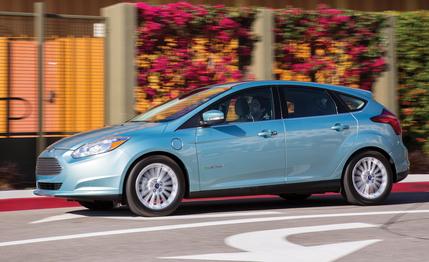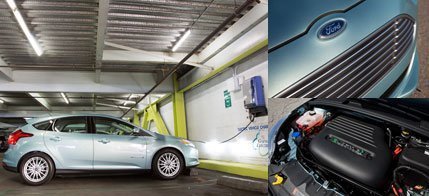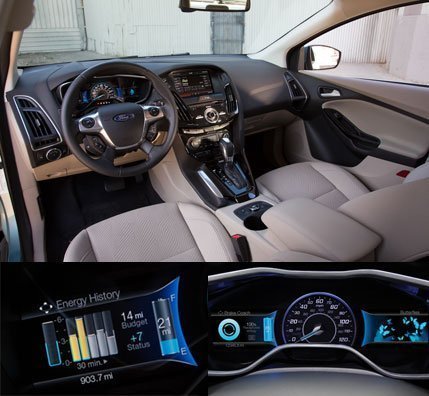
 Instrumented Test
Instrumented Test




Building an electric car from scratch has one major advantage: A clean-sheet design makes it easier to hide a large battery pack. But aside from optimizing the location of the heaviest part of the car, purpose-built electrics haven’t exactly been electrifying to drive. From the General Motors EV1 to the Nissan Leaf, electric cars designed from the jump to be electrics drive like fridges. And not even the cool stainless-steel and glass-doored kind. To make an electric car fun, we advise starting with a great gasoline-powered car and converting it to run on electricity. Tesla did just that with the Lotus Elise, which resulted in its sporty Roadster. Now Ford has taken one of our favorite five-door hatchbacks—the 10Best-winning Focus—and converted it to run on amps instead of gas.
Ford aims this vehicle directly at the purpose-built Leaf. We immediately noticed that the electric Focus acts a lot like any other Focus. You get the regular car’s solid chassis, refined manners, precise steering, and playful character. The Leaf is a lot less involving and gratifying to drive; it’s more simulation than stimulation. Score one for the converted car.
That said, the electric Focus is no stoplight king. A 141-hp AC motor sits between the front wheels and offers 188 pound-feet of torque at all times. The motor works against 3612 pounds of mass through a single-speed transaxle. Acceleration has the slow grace of a Lincoln Town Car. We clocked a 0-to-60-mph time of 10.3 seconds, a few tenths off the less powerful, nearly 235-pound-lighter Leaf. Remember 85-mph speedometers? The electric Focus could barely peg one; top speed is reported to be governed at 84 mph, but we managed 85 with our test vehicle. The Focus Electric covers a quarter-mile in 17.9 seconds, reaching 80 mph at that same time.
One interesting result of our evaluation was the discovery that the battery-operated Focus has a slight rearward weight bias—51 percent of the poundage sits over the undriven axle. That's due to the battery placement, which also lowers the center of gravity by about an inch compared to a gas Focus and contributes to this version's handling aptitude. (The Electric weighs 550-ish pounds more than a comparable conventional Focus hatch.) Roadholding is slightly lower than the numbers we've gotten from the Leaf —0.74 g versus the Nissan's best of 0.79. And braking is limited by the low-rolling-resistance tires, resulting in a long, 195-foot stop from 70 mph.


Like most alternative-powertrain cars, this EV has a number of information displays that goad drivers into extracting the most mileage from the battery’s electrons. Our favorite is the braking coach that displays what percentage of every stop’s kinetic energy makes its way back into the batteries. In lieu of speed, you can entertain yourself by trying to maximize your efficiency.
According to EPA tests, the Ford EV has a range of 76 miles on a single charge; on the same test, the Leaf scores 73. The Focus is slightly more efficient than the Leaf and returns a combined mileage number of 105 MPGe (miles per gallon equivalent) compared with the Leaf’s 99. That means the electric Focus can travel 100 miles for about 25 cents less than the Leaf. We saw 94 MPGe in our short test, and managed an 83-mile range on a trip that was roughly half city and half highway driving.
Another advantage for the Ford is that recharging the Focus’s 23-kWh lithium-ion battery from empty takes three to four hours on 240-volt power, or nearly half the time required for the Leaf (although we hear that Nissan will be upgrading the car's onboard charger for quicker refills soon). On 120 volts, a full charge of the Ford takes about 20 hours. Ford credits the battery’s highly effective cooling system for this. Unlike what Nissan offers for the Leaf, Ford isn’t making available a quick-charge 440-volt plug on the Focus, but there is less need for one.


A major disadvantage of the electric Focus is that its battery pack takes up a lot of space. Since this car wasn’t designed as an EV, the pack sits inside, under and behind the rear seat, like a giant suitcase you can’t remove. Say goodbye to hatchback practicality; there’s barely enough room back there for a set of golf clubs. Conversely, Nissan packages the Leaf’s battery under the floor, out of sight and out of the way. We grudgingly grant one point to the purpose-built EV.
For the foreseeable future, Ford’s EV will be somewhat rare. California, New Jersey, and New York get them first. By the end of the year, Ford will add 16 more markets; and by the middle of 2013, the electric Focus should be available nationwide.
Without taking tax incentives into account, the Focus starts at $39,995, and it comes nearly loaded, with MyFord Touch, a navigation system, and a Sony-branded stereo. The only available options are metallic paint ($395 or $495), leather-trimmed seats ($995), and the 32-amp, 240-volt home charger ($1499 installed). The electric Focus costs a couple grand more than a similarly well-equipped Leaf SL, at $38,100, but not only does the Ford replenish its battery faster, it is also not a fridge.